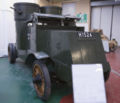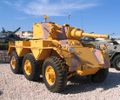Armoured cars
The term armoured car is commonly used for three types of vehicles. There is the armoured limousine type for the safety of VIPs, the security van/armoured truck type for the transport of valuables and military armoured cars
Civilian vehicles[edit]
-
A Mercedes armoured car
-
Run flat tyres for armoured limousines
-
Armoured truck in Barcelona
-
Armoured van in Manila
-
A Royal Mail armoured Mercedes van
-
ambulance
Military armoured cars[edit]
World War I[edit]
The automobile practise of custom coachwork allowed the grafting of armour and armament onto the chassis of commercial trucks and powerful touring cars.
-
A Rolls-Royce Silver Ghost, the basis of the Rolls Royce armoured car
-
British Rolls Royce Armoured car
-
GermanEhrhardt E-V/4
-
American King armoured car
-
US
-
Russian
Interwar period[edit]
In the aftemath of World War I Russian and German armoured cars were also used to maintain internal security. Sometimes referred to as combat cars later inter-war armoured cars were often used to allow armies to practise armoured warfare tactics in lieu of tanks.
-
Daimler DZVR 21 Schupo-Sonderwagen
-
Peerless armoured car
-
FAI armoured car
-
french
-
french
-
Rolls Royce 1920 Mk1
-
1929
World War II[edit]
The early World War II armoured cars refined the practise of militarised commercial chassis. With the availability of tanks armoured cars came to be used in the Armoured reconnaissance role.
-
M-3 Scout Car
-
BA-64
-
Lanchester Armoured Car
-
Polish museum
-
AMD Panhard 178
-
SdKfz 232
-
M38 Armored Car
Modern armoured cars[edit]
-
boxer
-
Spähpanzer Luchs
-
Ukrainian
-
Ukrainian
-
Ukrainian
-
Italian
-
Morocco
-
Armenian
Not immediately obvious in most vehicles, the power of modern armoured cars lies not so much in their armament but in their electronics and sensors, producing vehicles that act as the eyes of armoured formations.
-
A British Fox armoured car
-
The AMX 10 pairs a powerful gun with a first class fire control system
Counter-insurgency[edit]
For the counter-insurgency mission the tank killing capabilities of vehicles like the AMX-10-RC are un-needed. The wars in Iraq and Afghanistan have produced simpler armoured vehicles mating mobility, the firepower of a medium machine gun and protection from small arms fire, vehicles very similar in principle to the vehicles of the interwar era.
-
Honker Skorpion as used by Poland in Iraq
-
Iraqi Army on patrol in Mosul
-
Humvee with add on armour and machine gun copula in Afghanistan.
-
An improvised armoured vehicle belonging to a private security contractor in Iraq.
Internal security[edit]
Also sometimes referred to by the public as armoured cars are AFVs based on small APCs used for internal security.
-
Serbian Police BOV-M riot control vehicle
-
A Hong Kong police Saracen, an APC used by the British for internal security
-
A French Gendarmerie VBX
-
German Police vehicle
-
armoured truck
Other wheeled AFVs[edit]
Armoured cars are not the only wheeled AFVs. Other wheeled AFVs not usually considered armoured cars include:
-
Wheeled tank destroyers.
-
Wheeled armoured personnel carriers.
-
Wheeled infantry fighting vehicles.
-
Wheeled self-propelled artillery.










































































